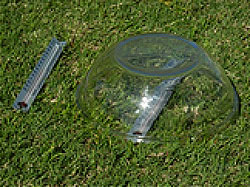The Greenhouse Effect: Warming the Earth
|
Image courtesy of U.S. National Park Service [1]. |
The Earth receives large amounts of energy from the Sun in the form of sunlight. Plants convert this energy into fuel for growth, in turn becoming food for many other animals. This energy (called solar radiation) warms our planet, stirs the atmosphere into motion, and drives our weather systems causing winds to blow, clouds to form, and rain and snow to fall.
Water vapor, carbon dioxide (CO2), and certain other gases in the atmosphere allow sunlight to pass through to the Earth’s surface. These same gases prevent infrared radiation (emitted by the Earth) from escaping back into space, thus trapping heat near the Earth’s surface. This is called the greenhouse effect because it resembles the way in which a garden greenhouse traps heated air.
The greenhouse effect is a natural process that keeps the Earth’s atmosphere at a temperature that is comfortable for most living things. The Earth’s average surface temperature is 15°C or 59°F. Without the greenhouse effect, much of Earth’s heat energy would be lost to space. The average surface temperature would be -18°C (0°F), significantly colder than it is now.
Our Experiment
In this activity you will demonstrate how the greenhouse effect warms the Earth. A glass bowl placed upside down on a grassy surface and exposed to sunlight represents gases and clouds in the Earth’s atmosphere; the grassy surface represents the Earth’s land surface. By measuring the air temperature inside and outside the bowl over 15 minutes, you can observe any differences caused by covering part of the grass with a glass bowl. You can work in groups of at least two or three on this project.
Note: This activity works best on a sunny day.
Tools and materials
- Two alcohol thermometers
- Clear glass bowl, big enough to cover one of the thermometers. A large, empty glass jar can work as well.
- Stopwatch
- Notebook
- Pen
- Hand magnifying glass (optional)
What to do
- Set up a table similar to the one below in your notebook.
| Time (minutes) | Outside temperature (°C) | Inside temperature (°C) | Predicted inside temperature (°C) |
| Start | |||
| 1 | |||
| 2 | |||
| 3 | |||
| 4 | |||
| 5 | |||
| 6 | |||
| 7 | |||
| 8 | |||
| 9 | |||
| 10 | |||
| 11 | |||
| 12 | |||
| 13 | |||
| 14 | |||
| 15 |
- Place the thermometers in a grassy place in the Sun. When they both read the same temperature record this reading as the “Start” temperature in the first row of your notebook table. (Tip: It might be easier to read the thermometers with a hand magnifying glass.)
-

You are going to cover one thermometer with the clear glass bowl; how do you think the temperature under the glass bowl will change over 15 minutes? In the table’s “Predicted inside temperature” column, write down your predictions.
- Place the bowl over one of the thermometers. The other thermometer should be next to the bowl but not underneath it. Make sure that no shadows are touching either thermometer.
- Start your timer immediately and record the readings from the two thermometers once a minute for the next 15 minutes.
- How did your results compare with your prediction?
- Draw a graph that shows the temperature of the air inside and outside the bowl over time.
- Explain your results.
Reflection questions
- In what ways does the Earth’s atmosphere act like the glass bowl?
- How would you redesign this experiment to better resemble the Earth’s atmosphere and surface?
- Can you think of ways to lower the temperature inside the glass bowl without removing any of the air? What processes in the atmosphere would this represent?
- How might you use technology with this activity?
|
|
|
 |
Digging DeeperFind out more about |
|
|
|
This content has been re-published with permission from SEED. Copyright © 2025 Schlumberger Excellence in Education Development (SEED), Inc.
- earth science [6]

